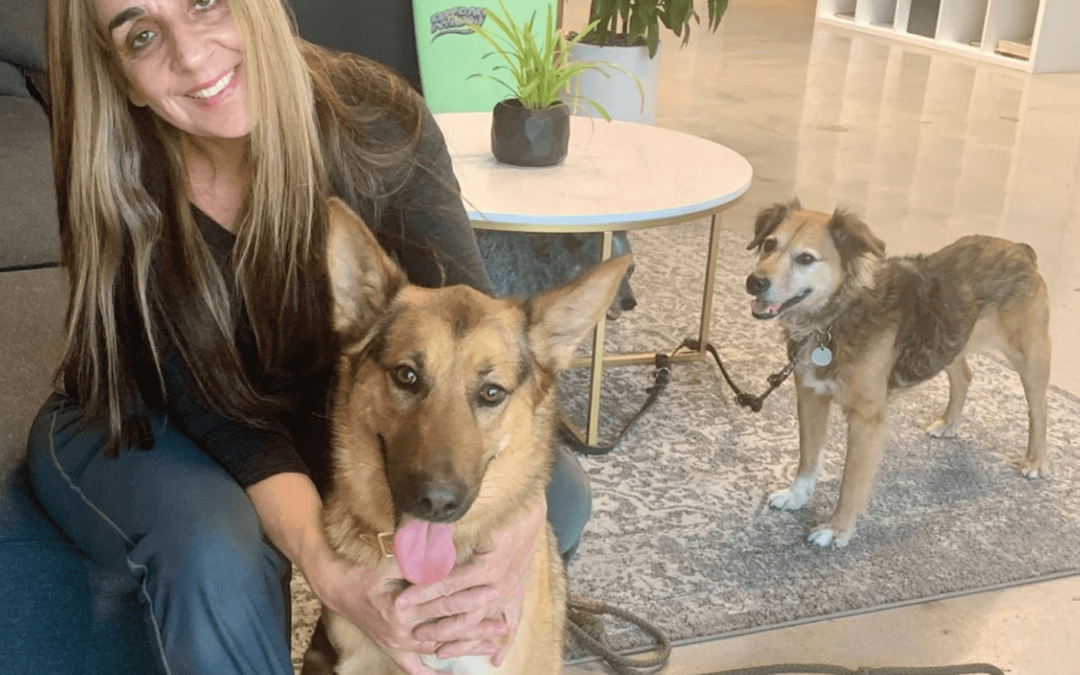Common Behavioral Problems in Dogs and How Professional Training Can Help
Struggling with dog behavioral problems? We can help! Dogs are incredible companions—loyal, affectionate, and often considered part of the family. But like people, they don’t come pre-programmed with perfect behavior. From leash pulling and jumping up on guests to excessive barking and aggression, dogs often develop habits that can frustrate owners and strain the bond between human and animal.
The good news? Most behavioral problems are not signs of a “bad dog.” They’re signs of miscommunication. Dogs are constantly trying to interpret their world and understand what’s expected of them. Without clear guidance, structure, and training, they may default to instinctual behaviors that don’t align with human expectations.
Professional training bridges this gap. It not only helps address unwanted behaviors but also builds mutual trust, strengthens communication, and enhances the overall quality of life for both dog and owner.
In this blog, we’ll explore the most common behavioral issues in dogs, break down why they happen, and explain how professional training can effectively address them.
Why Behavioral Problems Develop in Dogs
Before diving into specifics, it’s important to understand why dogs develop behavioral challenges in the first place. Some of the main factors include:
- Lack of socialization. Dogs that miss early exposure to different people, animals, and environments may struggle with fear, anxiety, or aggression later.
- Inconsistent rules. If a dog sometimes gets rewarded for jumping up but other times gets scolded, confusion leads to persistent misbehavior.
- Unmet needs. Dogs require mental stimulation, physical exercise, and companionship. Boredom and pent-up energy often manifest as “bad” behavior.
- Anxiety and fear. Loud noises, separation, or traumatic experiences can trigger destructive or defensive behaviors.
- Genetics and breed traits. Certain breeds are naturally more vocal, energetic, or protective. Without proper outlets, these instincts can appear as problems.
Understanding these root causes helps reframe misbehavior not as defiance but as a signal for better guidance.
Common Behavioral Problems in Dogs
Let’s break down the issues dog owners most frequently face, why they happen, and how training helps.
1. Leash Pulling
The Problem: Walking the dog turns into a tug-of-war. Instead of a relaxing stroll, owners end up dragged along the sidewalk.
Why It Happens:
- Dogs naturally walk faster than humans.
- They want to explore scents, sights, and sounds.
- Without training, they don’t know that leash manners are expected.
How Training Helps:
Professional trainers use techniques like loose-leash walking and heel training to teach dogs that calm walking gets them what they want: forward motion and exploration. Positive reinforcement (like treats or praise when the leash is slack) encourages the right behavior. Trainers also teach owners consistency—so the dog learns the rules don’t change depending on who’s holding the leash.
2. Excessive Barking
The Problem: Dogs bark at every sound, every passerby, or even when left alone. Neighbors complain, and owners feel helpless.
Why It Happens:
- Natural guarding instincts.
- Boredom or lack of exercise.
- Anxiety, especially separation anxiety.
- Reward cycles (if barking gets attention, the behavior continues).
How Training Helps:
Trainers identify the type of barking—whether it’s alert barking, demand barking, or anxiety-driven—and address the root cause.
- For demand barking, ignoring the behavior while rewarding quiet time works.
- For anxiety, desensitization and counter-conditioning help the dog feel more secure.
- For alert barking, trainers teach “quiet” commands and redirect the dog’s focus.
Training turns barking from an uncontrollable habit into a manageable behavior.
3. Jumping on People
The Problem: Guests enter the home and are immediately greeted with muddy paws and overexcited leaps.
Why It Happens:
- Dogs jump to seek attention or affection.
- Puppies learn early that jumping gets them noticed.
- Owners unintentionally reinforce it (pushing the dog down is still attention).
How Training Helps:
Trainers teach alternative greetings, such as sitting calmly for attention. Consistency is key—when every family member and guest ignores jumping but rewards sitting, the dog quickly learns the new rule. Professional trainers also provide controlled setups to practice polite greetings.
4. Aggression Toward People or Dogs
The Problem: Growling, snapping, or biting creates fear and risk.
Why It Happens:
- Fear or anxiety.
- Resource guarding (protecting food, toys, or space).
- Lack of socialization.
- Territorial instincts.
How Training Helps:
Aggression requires careful, professional intervention. Trainers work to:
- Identify triggers.
- Implement desensitization and counter-conditioning.
- Teach impulse control and alternative behaviors.
- Guide owners in safely managing situations.
In many cases, trainers collaborate with veterinarians or behaviorists to rule out medical issues and develop a holistic plan. Professional help is crucial here—mishandling aggression can make it worse.
5. Separation Anxiety
The Problem: Dogs panic when left alone—barking, howling, destroying furniture, or attempting to escape.
Why It Happens:
- Dogs are pack animals and struggle with solitude.
- Traumatic experiences of abandonment.
- Over-attachment to a single person.
How Training Helps:
Trainers create step-by-step desensitization plans. Dogs are gradually accustomed to short separations, paired with positive reinforcement. Tools like puzzle toys, calming environments, and consistent routines support progress. In severe cases, trainers may suggest working with veterinarians for medication alongside training.
6. Destructive Chewing
The Problem: Shoes, furniture, and personal items become chew toys.
Why It Happens:
- Teething in puppies.
- Boredom or lack of stimulation.
- Anxiety or stress relief.
How Training Helps:
Trainers redirect chewing to appropriate toys, teach commands like “leave it,” and help owners increase exercise and mental stimulation. Importantly, they also guide owners to dog-proof their home during training.
7. House-Soiling
The Problem: Accidents in the house despite potty training attempts.
Why It Happens:
- Inconsistent schedules.
- Medical issues.
- Anxiety or territorial marking.
How Training Helps:
Trainers reset the potty-training process with structure and consistency:
- Scheduled feeding and potty breaks.
- Positive reinforcement for outdoor elimination.
- Crate training as a management tool.
Professional trainers also spot when house-soiling signals a deeper issue, like urinary infections or anxiety, and guide owners accordingly.
8. Resource Guarding
The Problem: Growling, snapping, or biting when a dog is approached near food, toys, or resting spots.
Why It Happens:
- Instinctive protection of resources.
- Past experiences of scarcity.
- Anxiety around sharing.
How Training Helps:
Trainers use counter-conditioning to teach dogs that humans approaching means something good (like treats). They also train “trade-up” behaviors, where dogs willingly release items in exchange for rewards.
9. Overexcitement and Lack of Focus
The Problem: Dogs get so wound up that they can’t listen to commands or calm down.
Why It Happens:
- High-energy breeds without enough outlets.
- Lack of impulse control training.
- Overstimulation in busy environments.
How Training Helps:
Trainers teach impulse-control exercises like “sit and wait,” reward calm behavior, and incorporate structured play. By channeling energy into appropriate activities, dogs learn balance.
How Professional Training Transforms Dogs and Owners
Professional training isn’t just about fixing bad habits—it’s about reshaping the entire dog-owner relationship. Here’s how it makes a difference:
- Clear communication. Dogs learn what’s expected, and owners learn how to give consistent signals.
- Confidence building. Both dogs and owners gain confidence navigating stressful situations.
- Stronger bond. Training sessions become shared experiences that deepen trust.
- Long-term peace of mind. Owners no longer feel like they’re “fighting” their dog but working with them.
Training Approaches Professionals Use
- Positive Reinforcement: Rewarding desired behavior so it becomes more likely to repeat.
- Clicker Training: Pairing a clicking sound with rewards for precision.
- Desensitization and Counter-Conditioning: Gradually exposing dogs to triggers while pairing them with positive experiences.
- Management Techniques: Preventing access to situations where bad habits form while training takes effect.
- Structured Obedience Training: Teaching core commands that provide structure and safety.
These methods focus on humane, science-backed approaches rather than punishment, which can worsen fear or aggression.
The Role of the Owner in Training
Professional trainers provide the knowledge and tools, but owners must reinforce lessons daily. Consistency, patience, and commitment are essential. Successful training requires:
- Practicing commands outside of training sessions.
- Maintaining structure and routines.
- Avoiding mixed signals (e.g., allowing jumping sometimes but not others).
- Providing ongoing exercise and enrichment.
Training isn’t a one-time fix—it’s a lifestyle of clear communication and mutual respect.
Preventing Behavioral Problems Before They Start
While training can solve existing issues, prevention is just as important. Key preventive steps include:
- Early socialization. Exposing puppies to a wide range of experiences builds confidence.
- Obedience classes. Group classes provide structure and controlled socialization.
- Consistent routines. Feeding, walking, and sleeping schedules give dogs a sense of security.
- Mental enrichment. Puzzle toys, scent games, and training exercises prevent boredom.
Proactive training helps dogs grow into well-adjusted companions.
Your Dog Can Improve Now!
Every dog has quirks, instincts, and energy levels that sometimes clash with human expectations. But with the right guidance, structure, and patience, behavioral problems don’t have to define the relationship.
Professional training transforms not only the dog’s behavior but also the owner’s confidence and the overall bond. From leash pulling and barking to aggression and anxiety, the solutions are out there—and they work best when grounded in compassion, consistency, and clear communication.
When dogs and humans learn to understand each other, the result is harmony. Instead of daily frustration, life together becomes joyful, balanced, and rewarding.
So, the next time your dog pulls, barks, or misbehaves, remember: they’re not being “bad.” They’re waiting for guidance. With professional training and your commitment, that guidance can turn problems into possibilities—and challenges into opportunities to grow closer than ever.

